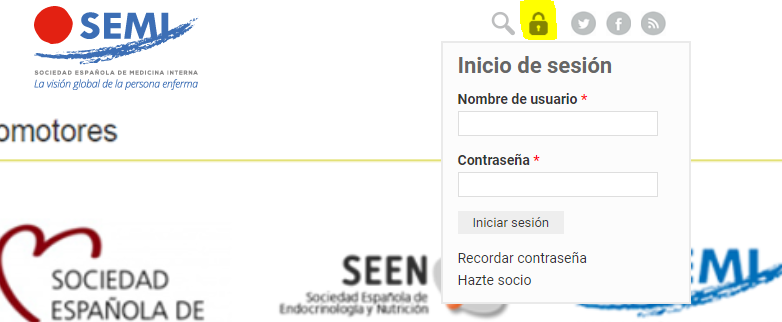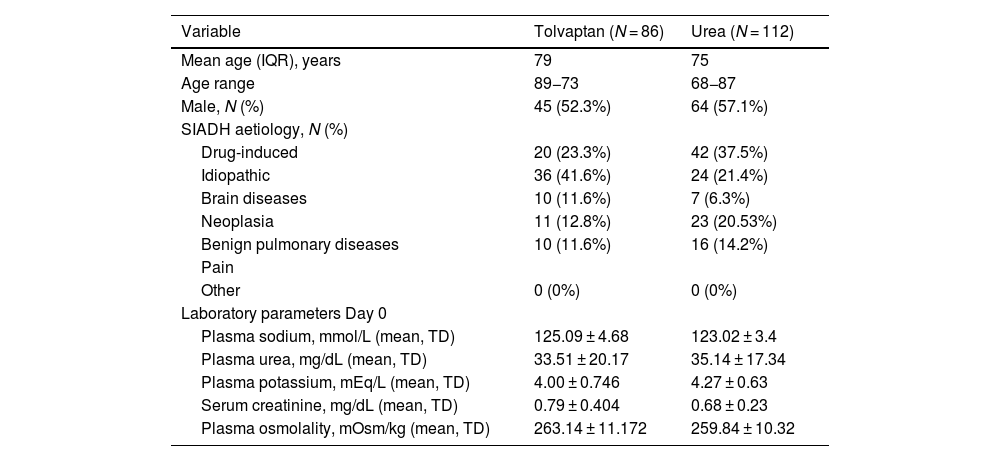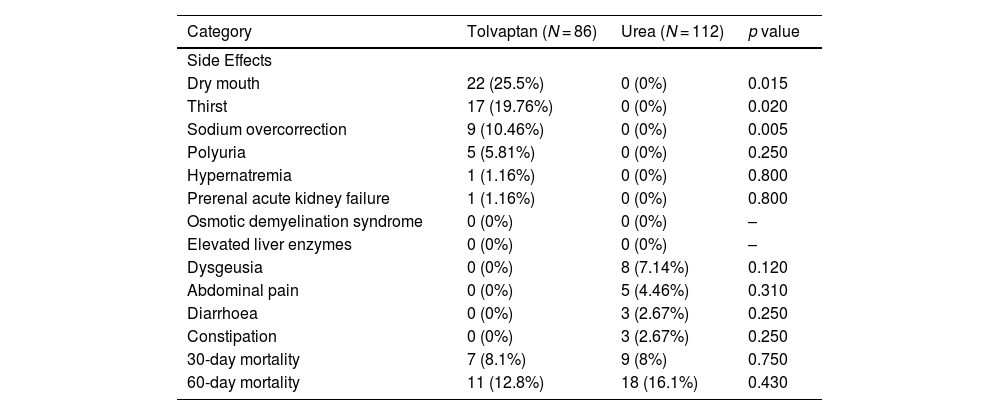Hyponatraemia is common in elderly and hospitalised patients, often caused by the syndrome of inappropriate antidiuretic hormone secretion (SIADH). This study evaluates the efficacy and safety of tolvaptan and urea in patients with hyponatraemia and SIADH.
Materials and methodsAn observational cohort study was conducted on 198 patients with SIADH and hyponatraemia (Na+ <135 mmol/L) at the Complejo Hospitalario Universitario de Pontevedra from January 2015 to May 2022. Of these, 86 were treated with tolvaptan (average dose of 7.5 mg) and 112 with urea (average dose of 15 g). The primary outcome was the normalization of sodium levels (Na ≥ 135 mmol/L).
ResultsThe tolvaptan group showed higher sodium concentrations at the end of therapy compared to the urea group (ME = 136, IQR = 135–137 vs. ME = 134, IQR = 132–137; p < 0.001). The time to normalise sodium was shorter with tolvaptan (4 ± 3.4 days) compared to urea (6 ± 3.6 days; p = 0.03). A higher percentage of patients achieved sodium normalization with tolvaptan (83.72% vs. 59.82%; p = 0.005). Tolvaptan had more adverse effects, such as dry mouth, thirst, and sodium overcorrection, while urea caused dysgeusia, abdominal pain, and diarrhea. There were no significant differences in mortality between the groups.
ConclusionsTolvaptan was more effective and quicker than urea in normalising sodium levels, though it showed a higher percentage of adverse effects, which did not require discontinuation of the drug.
La hiponatremia es común en pacientes mayores y hospitalizados, frecuentemente causada por el síndrome de secreción inadecuada de la hormona antidiurética (SIADH). Este estudio evalúa la eficacia y seguridad de tolvaptán y la urea en pacientes con hiponatremia y SIADH.
Materiales y métodosSe realizó un estudio observacional de cohortes en 198 pacientes con SIADH e hiponatremia (Na+ <135 mmol/L) en el Complejo Hospitalario Universitario de Pontevedra (enero 2015 - mayo 2022). De estos, 86 fueron tratados con tolvaptan (dosis media de 7,5 mg) y 112 con urea (dosis media de 15 g). Se evaluó la normalización de los niveles de sodio (Na ≥ 135 mmol/L).
ResultadosEl grupo de tolvaptán mostró concentraciones de sodio más altas al final de la terapia en comparación con el grupo de urea (ME = 136, IQR = 135–137 versus ME = 134, IQR = 132-137; p < 0,001). El tiempo para normalizar el sodio fue menor con tolvaptán (4 ± 3,4 días) en comparación con urea (6 ± 3,6 días; p = 0,03). Un mayor porcentaje de pacientes alcanzó la normalización del sodio con tolvaptán (83,72% vs. 59,82%; p = 0,005). Tolvaptán presentó más efectos adversos, como boca seca, sed e hipercorrección del sodio, mientras que la urea causó disgeusia, dolor abdominal y diarrea. No hubo diferencias significativas en mortalidad entre los grupos.
ConclusionesTolvaptán fue más eficaz y rápido que la urea en normalizar los niveles de sodio, aunque mostró un mayor porcentaje de efectos adversos, sin necesidad de suspender el fármaco.
Article
Diríjase desde aquí a la web de la >>>FESEMI<<< e inicie sesión mediante el formulario que se encuentra en la barra superior, pulsando sobre el candado.

Una vez autentificado, en la misma web de FESEMI, en el menú superior, elija la opción deseada.

>>>FESEMI<<<









